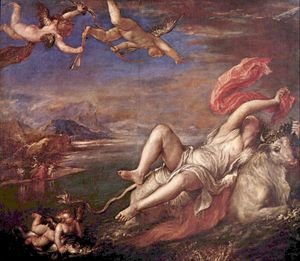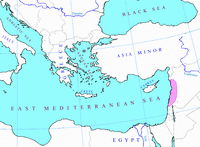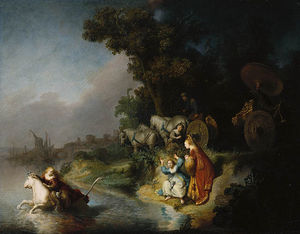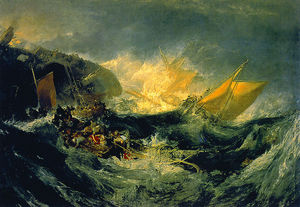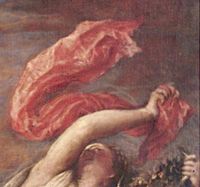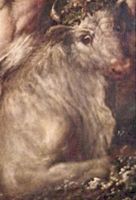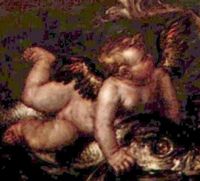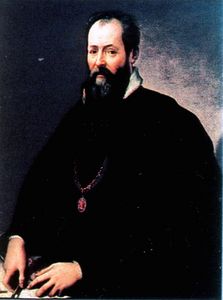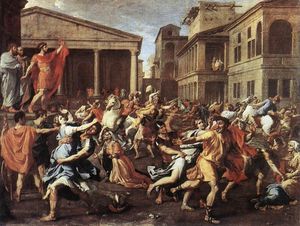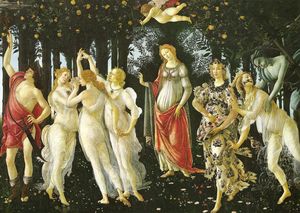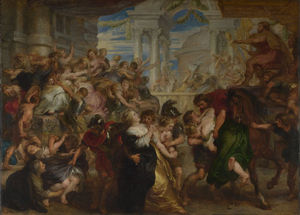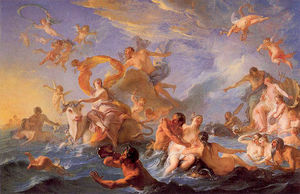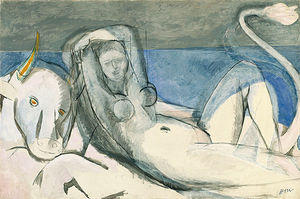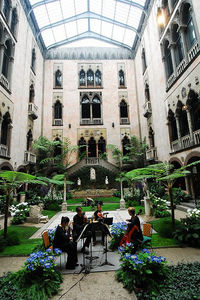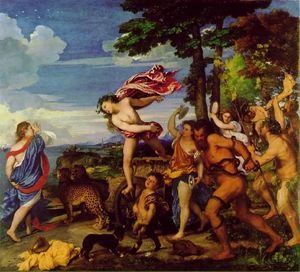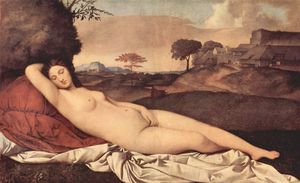Rape of Europa
- Date of Creation:
- 1562
- Height (cm):
- 185.00
- Length (cm):
- 205.00
- Medium:
- Oil
- Support:
- Canvas
- Subject:
- Figure
- Art Movement:
- Renaissance
- Created by:
- Titian
- Current Location:
- Boston, Massachusetts
- Displayed at:
- Isabella Stewart Gardner Museum
- Owner:
- Isabella Stewart Gardner Museum
Rape of Europa Story / Theme
Titian's painting of Rape of Europa tells the story of a young woman, named Europa, who was abducted and raped by the god Zeus, who had taken the form of a docile white bull.
According to legend, Europa was a Phoenician princess and descendent of the nymph Io. It is possible that she was the daughter of King Agenor of Tyre, though some versions of the myth claim Phoenix was her father. Her mother's identity also remains a mystery, with some versions naming Telephassa and others claiming Argiope, while others say these two women are one in the same.
Regardless of her parentage, Europa was believed to have been a Phoenician princess, living in an area occupied by present day Syria, Lebanon and Israel.
One day, Europa was frolicking and picking flowers by the Mediterranean Sea when Zeus - king of the Greek gods - spotted her and fell instantly in lust. He transformed into a gentle white bull and positioned himself in the meadow where Europa would surely find him. Naturally, she did. But, rather than being fearful of the large beast, she was struck by his calm and sweet demeanor and placed a garland of flowers around his horns.
She felt so comfortable with this bull that she even climbed upon its back, at which point, she was exactly where Zeus wanted her. Zeus, still disguised, ran toward the sea with the frightened girl clinging helplessly to his back. He dove into the water and transported Europa to the island of Crete, where he revealed his true form and forced her to be his lover.
Europa subsequently gave birth to three sons, Minos, Rhadamanthus and Sarpedon. Some legends also say that Zeus bestowed upon Europa four valuable gifts along with her three sons - a necklace forged by Hephaestus (the blacksmith god); the bronze man and protector of Crete named Talos; Laelaps, a hunting dog that always caught what it pursued; and a javelin that never missed its mark.
It is also believed that, once their relationship ended, Zeus created the constellation Taurus to commemorate their time together and his super clever disguise.
Europa went on to marry the king of Crete, who adopted her three half-divine sons. Her son Minos would become the famous Cretan king who demanded Athenian tribute to be paid in the form of sacrifices for his gruesome Minotaur - the half-man, half-bull creature that lived in the Labyrinth on Crete.
Rape of Europa Inspirations for the Work
Commission:
King Philip II of Spain commissioned this work from Titian - a favorite artist of both him and his father, Charles V, Holy Roman Emperor. The work was completed for Philip II's private poesie collection, a collection of paintings depicting Greek and Roman myths that Titian worked on for a number of years.
Rape of Europa - depicting a nude or semi-nude woman in a position of inferiority while a powerful god or man calmly controls the action - was very popular among aristocratic society in Renaissance Italy. This was a type of erotica that catered especially to men who, due to their elevated positions in society, believed themselves to be god-like and were able to live vicariously through the exploits of the gods, such as in this scene.
Not only did such images serve as erotica, but they also paralleled a leader's possession of his subjects, in this case with Europa representing Spain, perhaps, and Zeus as the bull representing Philip II.
Through the use of violence and trickery, Zeus is able to totally subjugate Europa - a somewhat frightening parallel for what leaders envisioned for themselves and their charges.
Mythology:
For all the paintings in Philip II's poesie collection, Titian relied heavily on the writings of Ovid's Metamorphoses to render his mythological paintings. Ovid was a Roman poet whose Metamorphoses was completed around AD 8 and was meant to be a complete history of the known world. The myths and stories he imparts through this poem have been some of the most influential writings in Western culture, particularly where art is concerned.
Titian may have used the following passage to paint this scene.
"And gradually she lost her fear, and he
Offered his breast for her virgin caresses,
His horns for her to wind with chains of flowers
Until the princess dared to mount his back
Her pet bull's back, unwitting whom she rode.
Then - slowly, slowly down the broad, dry beach -
First in the shallow waves the great god set
His spurious hooves, then sauntered further out
'til in the open sea he bore his prize
Fear filled her heart as, gazing back, she saw
The fast receding sands. Her right hand grasped
A horn, the other lent upon his back
Her fluttering tunic floated in the breeze."
Rape of Europa Analysis
Movement:
Rape of Europa is a painting in constant motion, befitting the unexpected and violent kidnapping that has just taken place. Three of Europa's four limbs are flailing in a wild panic while her left arm grips the bull's horn, lest she fall into the churning sea.
In her right hand, she waves a long red piece of fabric, perhaps as a distress signal, that seems to be caught in the wind. The bolt of fabric is pinned between Europa and the bull's back and is dragged carelessly through the sea, creating a visually continuous line that helps move the viewer's eyes around the central action on the right side of the canvas.
To heighten the feeling of movement, Titian included flying putti - winged, cherub-like creatures that appear frequently in secular and religious Italian art - in the sky above Europa and Zeus, the bull. The putti appear to be trying to assist the distressed princess, reaching for her and spiraling forward through the air. Europa herself is either looking at them or back at the shore where her companions are waving madly.
In stark contrast, the bull seems to be relatively composed - strongly and stoically propelling himself and his captured cargo forward through water. His tail, however, seems to twitch in anticipation of his new possession.
Mood, tone and emotion:
Titian created in Rape of Europa an emotionally-layered work, successfully conveying the complexities of and similarities between fear and desire. According to some scholars, Europa's open and somewhat indecent posture and expression are a clear indication that she is totally possessed by sexual desire.
On the other hand, her expression is also unequivocally one of terror - she has just been snatched from her home and the safety of land by a seemingly docile creature. She knows nothing of her future and has no control over the events that will come to define her life.
Though Europa's overall emotional state is potentially laced with feelings of excitement, the real excitement lies in Zeus. His bloodshot and intense eyes convey a haughty satisfaction that he will soon have his way with this trusting girl, that he has made a successful conquest and holds the power.
This mood was perhaps meant to be reflected in that of Philip II when he gazed upon this painting in his private collection.
Color palette:
It is nearly impossible to discuss a painting by Titian without mentioning his superb use of color - a style and command of the pigments that is unsurpassed by his contemporaries and that many have tried to emulate.
Titian's stormy sky in the top and right of the canvas reflects the swirl of emotions expressed by Europa - what some scholars see as shades of both of dread and desire. The murky colors are quickly sweeping in to cover the bright and cheery blue.
The way Titian was able to paint Europa's clothing which is draped haphazardly and clinging suggestively to her body, is further testament to his skill with color.
He incorporates shading and highlighting so expertly that the viewers can tell that Europa's garment is slightly transparent - perhaps a byproduct of being dragged through the sea. He has also painted her red shawl (perhaps red to reflect passion?) in a way that allows it to catch the last glimmers of light as she waves it relentlessly through the air.
Rape of Europa Critical Reception
During life:
After Titian completed Rape of Europa and presented it to the King of Spain, Philip II, it is very likely that few people would have ever seen the work. It was painted for the king's private art collection, presumably for him to enjoy alone or with family members or guests.
The primary purpose of this type of image was to afford erotic stimulation while serving as a visual representation of the aristocracy's claim to absolute power, and there is no indication that King Philip II was displeased with Titian's efforts.
In fact, it appears that Philip II felt quite the opposite toward Rape of Europa and other paintings in the poesie. According to Vasari, "these paintings are in the possession of the Catholic king [Philip II], and they are held most dear because of the vitality Titian gave to his figures with colors that made them seem almost alive and very natural."
Paintings depicting similar scenes, such as the Rape of the Sabine Women and Primavera were wildly popular during the Renaissance, and were frequently presented as wedding gifts due to their marital and sexual overtones.
After death:
Presumably only a small handful of people ever saw this work while it was housed in Philip II's private collection. It wasn't until it was transported to the palace at Alcazar and later the Prado museum along with the rest of the poesie that it was available to the public.
In the 17th century, women were restricted from viewing Rape of Europa and the other paintings in the poesie as it was believed they would have been offended by the abundant nudity. Furthermore, according to Dr. Frances Van Keuren, the women would have felt a sympathy for female suffering that "would have limited their ability to appreciate other positive features of the paintings, such as the beauty of the ideal female forms, which was much praised by contemporary male poets."
Beyond this, Rape of Europa was honored by scholars for representing an ideal wife - chaste, submissive, willing (or forced) to make sacrifices for her country and family. Zeus, as the bull, was viewed by the same scholars as representing a good leader of the times - powerful, cunning and possessing a healthy sexual appetite.
Critics from the Renaissance until well into the 20th century viewed Europa as a willing - and perhaps eager - participant in this act. But, such a classification of the princess as feeling desire for her captor begs the question of why the painting is titled with the word "rape."
According to Richard B. Carpenter, "The driving rage of a subhuman masculine sexuality has never been so magnificently revealed with such limited means. The forces at work within and between these two creatures are so primal and of such power that they break across the lines of species. It is the overwhelming, yet intangible forces of masculine and feminine passion that reconcile woman and bull, so that the relation between them is made convincing."
As the 20th and 21st centuries progressed, critics began to focus their attention on this theme in art - the "heroic" rape - as more of an abomination than an artistic expression.
While the idea of a glamorized rape and all that it represents was an accurate parallel for the ideological values of Renaissance rulers, many modern critics have balked at the notion of honoring such a violent and selfish act, but recognize its context in Renaissance art and society.
Rape of Europa Related Paintings
Rape of Europa Locations Through Time - Notable Sales
Today, Rape of Europa is housed at the Isabella Stewart Gardner Museum in Boston, Massachusetts, where it has lived since it was purchased through Bernard Berenson from Colnaghi, London in 1896. Forty years earlier, Europa was sold to the Earl of Darnley and Colnaghi at Christies.
Rape of Europa Artist
Titan, born Tiziano Vecelli, is the artist responsible for firmly establishing the Venetian school of painting as a major player in Renaissance art. He is best-known for his bold use of color and vivid brushstrokes that can, at times, seem more like paintings from the Impressionist period than the High Renaissance. This style has led some scholars to refer to him as the proto-Modernist painter.
Titian maintained a close relationship with both King Philip II of Spain and his father, Charles V, Holy Roman Emperor, for whom he painted dozens of portraits and mythologies, such as Rape of Europa, for much of his lengthy career.
Rape of Europa Art Period
Titian lived and painted when the Renaissance was in full-swing throughout Italy and when it was beginning to flourish throughout Europe. He was especially involved in the ideological conflict between the Venetian and Florentine schools of painting in Italy.
Venetian artists such as Titian, Bellini and Giorgione, were ultimately more concerned with producing paintings that appealed to the senses - paintings with a depth of feeling, seductive colors and fanciful lighting.
Artists in Florence and Rome, such as Michelangelo and Raphael, were primarily concerned with producing works that were anatomically, geometrically and architecturally accurate, sometimes at the expense of sensual pleasures.
Rape of Europa Bibliography
For further reading on Titian, please choose from the following recommended sources.
• Biadene, Susanna. Titian: Prince Of Painters. Marsilio Editori, 1990
• Bowron, Edgar Peters. Titian and the Golden Age of Venetian Painting (Museum of Fine Arts, Houston). Yale University Press, 2010
• Hudson, Mark. Titian: The Last Days. Bloomsbury Publishing, 2009
• Humfrey, Peter. Titian. Phaidon Press Ltd, 2007
• Ilchman, Frederick, et al. Titian, Tintoretto, Veronese: Rivals in Renaissance Venice. Lund Humphries, 2009
• Pagden, Sylvia Ferino & Scire, Giovanna Nepi. Later Titian and the Sensuality of Painting. Marsilio,Italy, 2008

